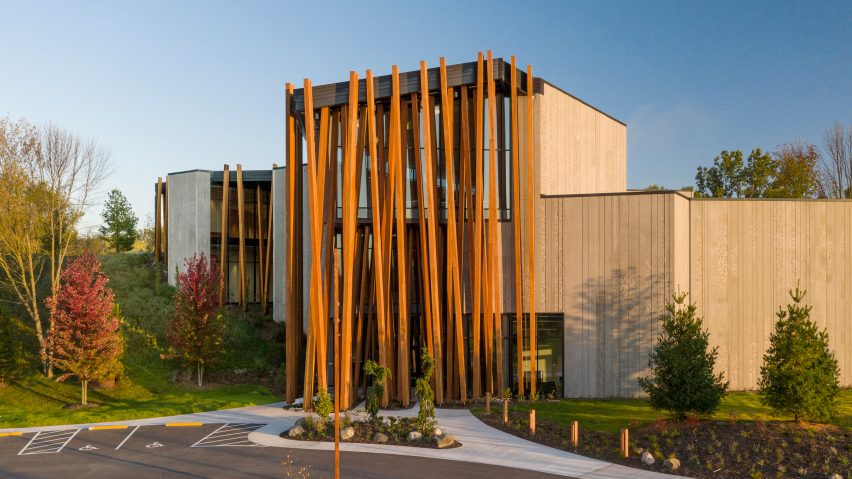Work by self-taught artists will be displayed within a Douglas fir-wrapped museum in eastern Wisconsin designed by US firm Tres Birds Workshop to evoke the natural landscape.
Slated to open this June, The Art Preserve is described as the world's first museum devoted to "art environments" – spaces created by artists, typically in their own homes and yards. Often, the creators have no formal art training.
The three-storey facility is located in Sheboygan, a small city about an hour's drive north of Milwaukee. The project was designed by Tres Birds Workshop, a Denver studio focused on economical and sustainable design.
The new museum is part of the John Michael Kohler Arts Center, a nearby cultural venue that is dedicated to contemporary work by vernacular and self-taught artists, along with artists who are academically trained.
The independent, nonprofit centre was established in 1967 with support from the Kohlers – the family behind the Kohler Company, a leading manufacturer of plumbing fixtures.
The new museum sits on a grassy and tree-dotted hillside, adjacent to the Sheboygan River.
Encompassing 56,000 square feet (5,203 square meters), the building will house more than 25,000 pieces from the Kohler Art Center's collection.
The building encompasses a range of spaces, including galleries, an education area, a library and visible storage spaces. The architects used what they call a "walk-in-the-woods approach" to foster interaction between the artwork and the outdoor environment.
"Engaging the landscape in its design, the building will feel as if it has grown organically out of the hill and meadow site," the team said. "Visitors will view the artworks with nature as a backdrop."
Irregularly shaped in plan, the building is tucked into a gently sloping site.
Exterior walls are composed of concrete panels – portions of which feature an aggregate made of locally sourced river rock. The same material was used inside the building, for floors, stairs and some walls.
Around the exterior, the team placed tall, angled strips of timber that visually tie the building to its natural context while also providing shade.
Fabricated in Wisconsin, the custom strips are made of glue-laminated boards of Douglas and hemlock fir. They range in height from 14 to 62 feet (four to 19 metres).
"These 'timber shades' shield the collection from continuous direct sunlight through the windows, while still providing directs view out to the trees, river and meadow from within the museum," the architects said.
Inside, the museum has a mix of below- and above-grade spaces. Subterranean areas have concrete walls, while upper levels have white walls and windows.
Connecting all three levels is a central staircase illuminated by daylight. Made of concrete masonry units, the walls of the stairwell are designed to evoke striations in the landscape.
"Colour differentiation within the courses of the blocks helps to map the topography of the building site," the team said.
The Art Preserve was the brainchild of the Kohler Arts Center's longtime director, Ruth DeYoung Kohler II, who died in 2020 at the age of 79. The museum was scheduled to open last August, but the date was pushed back due to the coronavirus pandemic.
Work by more than 30 artists from around the globe displayed, such as wood carvings by American folk artist Levi Fisher Ames and rooms by Missippii artist Loy Bowlin covered in glitter, paint, collages and paper cutouts.
In addition to serving the general public, the centre will be a place for academic study and research.
Founded in 2000, Tres Birds Workshop has completed a number of projects in Colorado and beyond, including a Denver sushi restaurant that has a wall composed of reclaimed bricks and custom-made crystal blocks.
Photography is by James Florio unless otherwise stated.
Project credits:
Architecture, site planning, interiors: Tres Birds
Exhibitions: Tres Birds in collaboration with John Michael Kohler Arts Center
Landscape design: Tres Birds in collaboration with Michael Beeck of Otter Creek Landscape
Engineer: Arup

